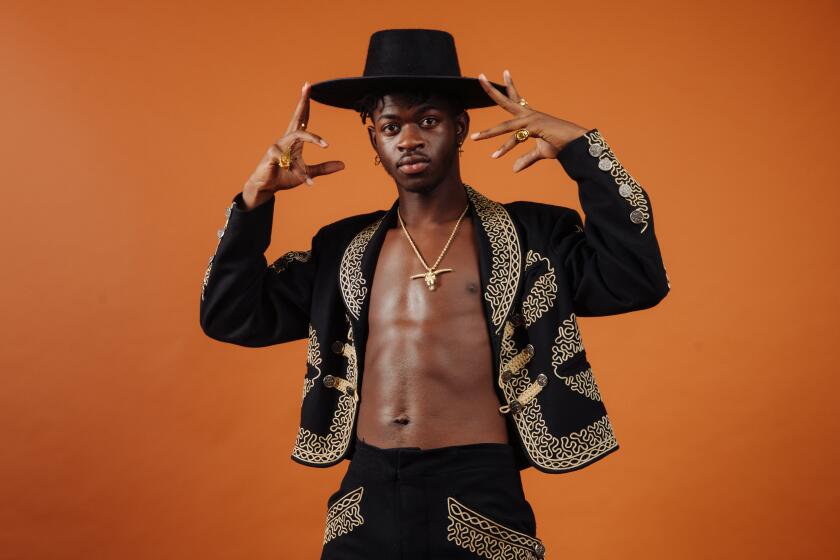O.C. POP MUSIC REVIEW : Blasters, James Harman Rock Steady Again
- Share via
SAN JUAN CAPISTRANO — With intertwined pasts and a shared affinity for blues tradition, the Blasters and the James Harman Band both made significant contributions to the back-to-roots musical movement of the 1980s.
But each band--the Blasters from Downey and the Harman group based in Huntington Beach--went through a difficult transition during the late ‘80s because of key personnel changes. Now stability is setting in again, with each band having played as a unit for 1 1/2 to 2 years.
While it won’t be possible to truly judge the character and direction of the post-shake-up Blasters and Harman Band until each has documented its new lineup by putting out a record (something that doesn’t appear to be immediately in the offing for either band), their recent appearances at the Coach House within two nights of each other offered a chance for a status check on two veteran, roots music groups as they enter a new decade.
The biggest question facing the Blasters is the same in 1990 as it was in 1986: How well can it carry on without the distinctive songwriting voice of Dave Alvin? With no albums since 1985’s “Hard Line,” singer Phil Alvin (Dave’s older brother) and the other Blasters have been slow in supplying a definitive answer.
Alvin says the delay has been due partly to his own wariness concerning the economics of the music business, which he feels is stacked steeply against artists and in favor of record companies. The Blasters also had trouble stabilizing the lead guitar slot after Dave Alvin’s departure. James Harman Band alumnus Michael (Hollywood Fats) Mann died a few months after joining the Blasters in 1986, and then an alliance with former X guitarist Billy Zoom didn’t pan out. Since 1988 the Blasters lineup has solidified with new guitarist Greg Hormel joining Phil Alvin, bassist John Bazz, drummer Bill Bateman and regular guest saxophonist Lee Allen.
Playing at the Coach House on Thursday night, the Blasters didn’t settle the question of new material, as they drew mainly on songs from the Dave Alvin period as well as blues, country and rock ‘n’ roll covers. But the 95-minute show made it clear that the band’s sharpness and versatility are undiminished, and that Phil Alvin remains the sort of singer who can bring to life the story embedded in a song.
That ability of Alvin’s could give the Blasters a credible path to follow even if they aren’t able to come up with an album’s worth of original songs to match their past output. On his 1986 solo album, “Un ‘Sung’ Stories,” Alvin put his own stamp on traditional jazz, blues and gospel material. There’s no reason to think the Blasters couldn’t do the same for strong outside material if their songwriting well turns up dry.
Alvin’s power as a singer-storyteller came across clearly in his handling of the blues chestnut “Got Love if You Want It.” This is one song that you’d think had been sucked dry through familiarity, with any hint of freshness or meaning squeezed like the final trace of moisture from a thirsty Bedouin’s goatskin.
But Alvin turned it into a searing plea, the desperate gambit of an obsessed lover who lays his feelings on the line, with all sense of manhood and ego staked on how the woman will respond. It wasn’t a bad piece of work for a singer who announced at the start that he had a sore throat. From time to time through the show, Alvin would clutch at his throat as if he had just escaped a close encounter with Count Dracula. Despite the pain, his voice sounded almost as big and brassy as ever.
The Blasters played one new original that held up well: “4-11-44,” a sardonic, rockabilly-based number that continues the band’s longstanding working-class allegiance by depicting the state lottery as just another way in which society stacks the economic odds against poor people.
The lyrics weren’t subtle (“If you’re working hard and getting paid/4-11-44/It’s custom built for the busboy and the hotel maid”), but the song rocked emphatically and the lotto-number refrain sticks in the memory on first hearing.
Alvin said after the show that “4-11-44” is one of three numbers the Blasters have recorded on their own so far with an eye toward an album release this spring--pending negotiations with labels. The others are a Johnny Paycheck number, “The Only Hell My Mama Ever Raised,” which was a country stomper in concert, and “Brother on the Line,” an excellent Dave Alvin song that received a suitably anguished reading.
Hormel’s guitar work abided by time-honored rockabilly and blues conventions, yet it was anything but canned. He avoided staleness by putting spark and immediacy into familiar playing patterns, and by keeping things concise. While Phil Alvin certainly has the assurance and personality to command the stage, it would have helped if the generally self-contained Hormel could have brought an additional expansive element to the show.
The James Harman Band, in its longtime configuration with David (Kid) Ramos on guitar, Willie J. Campbell on bass and Stephen Hodges on drums, could exude an irresistible group personality in which each member projected a glee for playing the blues in all its dimensions. With good reason, Harman nicknamed that lineup “Those Dangerous Gentlemens.”
Ramos and Campbell left the band in mid-1988, and guitarist Joel Foy and bassist Jeff Turmes took over their slots alongside Harman and Hodges. You couldn’t say that these gentlemens were dangerous Saturday night at the Coach House. Instead, they were comfortable and natural, playing basic blues in an uncontrived way that came across vividly without straining for effect.
Nobody would ever call Foy dangerous. Where Ramos was a muscular Rambo of the blues guitar, Foy--with his bony build, thinning hair and thick dark eyeglass frames--looks more like Woody Allen. As he soloed, he would hold still and concentrate on his guitar with the somewhat concerned look of a chemist who is carrying a vial of volatile stuff that he would rather not slosh around too much.
But Foy’s playing was an impressive compound of skill, nuance and control. He frequently got a rippling, liquid tone from his hollow-bodied guitar--a tone that was so evocative on the bayou blues of “Swampy Night” that it made you visualize the reflection of a full Louisiana moon shimmering on water. A lot of that comfortable, unforced aura about this Harman lineup comes from Foy’s unassuming manner and his light, meticulous touch on the guitar.
At 43, Harman comes to the blues and to his front man’s role with all the ease and charm that anybody could want, and there are few more capable blues singers or harmonica players around. Anyone who can’t get a lift from the humor and lively spirit in Harman’s act belongs at a Cure concert.
Harman was confident and comfortable enough to mosey into his show with 25 minutes of the most traditional, down-home kind of blues there is--laid-back stuff, played with the band sitting down. For his opening number, Harman sang through an old microphone (usually reserved for his harmonica) that gave his vocal the scratchy tone of an old 78 rpm record. The effect was playful, not archival, but it signaled that the audience was in for some authentic stuff.
Most of the set continued in a brisk but low-key, folksy vein (in a homey, not to mention tasty touch, barbecued ribs were passed around to everybody in the house midway through the show, courtesy of Fred Burrell, the Santa Ana barbecue king credited with providing gustatory “inspirinment” for Harman’s “Extra Napkins” album).
Harman ended with some of the more rocking, dangerous numbers in his repertoire, including the Bo Diddley beat raver, “Kiss of Fire.” While the playing generated plenty of heat, especially from Hodges’ thundering drum rolls, the performance itself wasn’t quite cathartic. A bit more all-around group fire and mayhem would have helped.
This version of the James Harman Band should have no problem pleasing fans of pure blues. (It will be a while before they get to establish an identity on record, since Harman’s next album, “Strictly Live in ‘85,” features a live set by the old lineup that included both Ramos and Hollywood Fats on guitar).
More open to question is whether this lineup can serve as a vehicle for another crack at the mainstream, rock-oriented audience that Harman tried to reach with his old band on the 1987 album, “Those Dangerous Gentlemens.” That’s where the big money lies, the gold ring that has been seized by the likes of Robert Cray and the Fabulous Thunderbirds. But a band that does straight blues this well already occupies a musically valuable niche of its own.
More to Read
The biggest entertainment stories
Get our big stories about Hollywood, film, television, music, arts, culture and more right in your inbox as soon as they publish.
You may occasionally receive promotional content from the Los Angeles Times.











